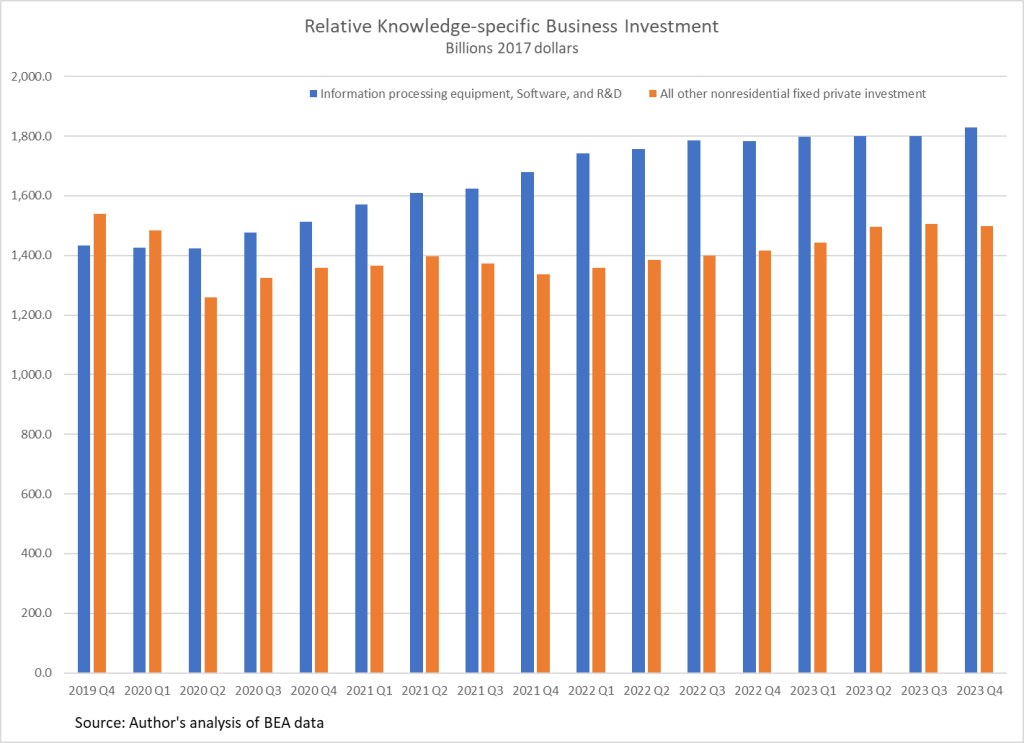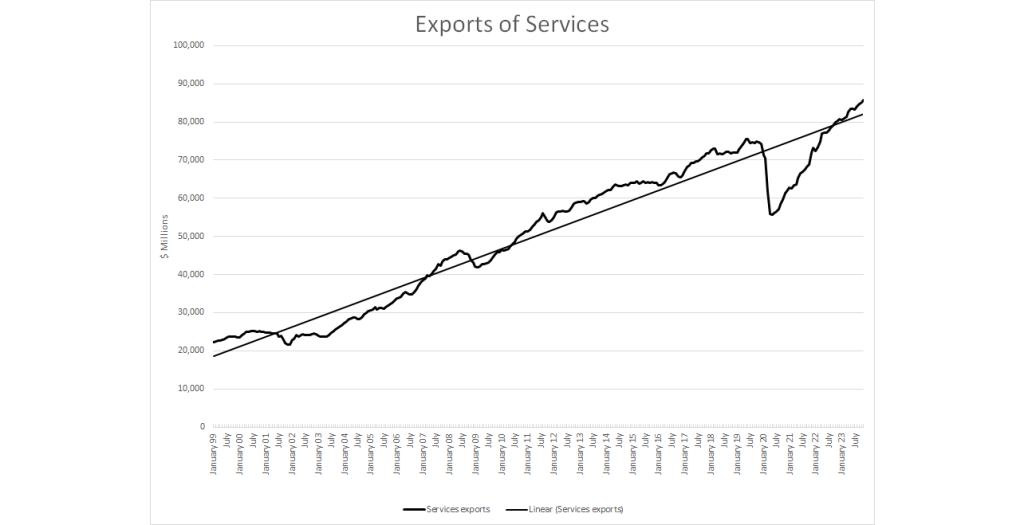In its Christmas Special, The Economist speculates on the future of generative AI using a vignette on the development adoption of an earlier technology. The technology involved? The tractor. Here’s how the story goes. Replacing horses with tractors was supposed to greatly increase farm productivity. But, according to the article’s author, it did not. “Over the sweep of history the tractor has indeed had an immense impact on people’s lives. But it conquered the world with a whimper, not a bang.” The reason they argue, is straightforward. “The slow diffusion of the tractor produced slow productivity gains.”
The article cites three factors that slowed diffusion:
“First, early versions of the technology were less useful than people had originally believed, and needed to be improved. Second, adoption required changes in labour markets [so that the cost of workers was higher than the cost replacing them with machines thereby creating an economic incentive for adoption], which took time. And third, farms needed to transform themselves [into larger organization who could both afford the capital outlays required and deploy the technology so as to take advantage of the productivity potential].”
According to the Economist’s analysis, the same dynamics is at play with generative AI:
“The history of the tractor hints at how quickly generative AI may take over. At present most AI models still have metal wheels, not rubber tyres [metal wheels were a major factor limiting the use of tractors in muddy fields]: they are insufficiently fast, powerful or reliable to be used in commercial settings. Over the past two years real wages have hardly grown as inflation has jumped, limiting companies’ incentives to find alternatives to labour. And companies have not yet embraced the full-scale reorganization of their businesses, and in-house data, necessary to make the most of AI models. No matter how good a new technology may be, society needs a long, long time to adjust.”
That last statement is a well establish truism: technologies take time to develop and have an impact. But it is also a well establish truism that adoption rates are different for different technologies. The definition of “a long, long time” depends heavily on the nature of the technology and the specifics of the time.
Contrary to the Economist’s thesis, the specifics of generative AI are such that the adoption of the tractor (or even the broader industrialization of agriculture) is not a useful model as to how AI will develop. There are two reasons why. First, it is not clear that the tractor should be placed at the heart of the agricultural productivity story. Pardey and Alston point out in their paper “The Drivers of U.S. Agricultural Productivity Growth,” that tractors were part of a larger development:
“A series of mechanical innovations transformed U.S. agriculture, including tractors, mechanical reapers, combines, and related bulk-handling equipment, which progressively replaced horses and other draught animals and much human labor. These innovations were particularly pronounced in the early decades of the twentieth century. As well as these on-farm changes, farmers benefited from improved technology for long-distance transportation of farm output (including refrigeration and preservation technologies), coupled with investment in roads, railroads, and other public infrastructure (such as those related to rural electrification, telephone service, and irrigation projects).”
Thus, the impact of the tractor is embedded in a variety of other factors, including the development of concomitate technologies.
And a large part of the productivity story is organizational, rather than technological. According to Pardey and Alston, the period of 1920-1970 was a time of economic transition, “accompanied by an acceleration in farm productivity growth, associated with an acceleration in the rate of farmers exiting the industry, enabling a consolidation of farms into larger operations.”
Larger farms could operate more efficiently due to economies of scale and scope. The restructuring of the agricultural sector and the consolidation of smaller farms into larger farms also opened the door to great adoption of tractors. As the Economist points out, “Tractors worked best on big farms, where the farmer could spread out the expense of a huge upfront investment.” While cheaper in the long run, tractors and other farm equipment require a substantial up-front outlay. Large farms could afford such a capital outlay; small farms with less financial resources and more limited access to capital could not.
And of course, the incorporation of greater mechanization (including tractors) contributed to greater efficiency. This created a self-reinforcing cycle that led to the industrialization of agriculture (see earlier posting on why agriculture is “strategic”).
Thus, the tractor was part and parcel of a larger set of forces that transformed agriculture. This points to the need to understand generative AI in the context of the larger economic situation and to understand the interplay of the forces shaping the economy. Those forces affecting the development today of generative AI are very different from the forces 100 years ago. Consequently, the analogy with the development of the tractor is severely limited.
Second, even the specific factors affecting the deployment of generative AI are different from those that impacted the adoption of the tractor. The factors affecting the adoption of the tractor (as described above) are versions of some of the well-recognized factors in technology diffusion.
- The new technology is not quite as good as the current technology. As a result, the new technology is only used in specialized uses where its specific features have an advantage over the current technology. An example is semiconductors/integrated circuits advantage in weight and size over vacuum tubes for aviation and space uses.
- The current technology continues to be more cost effective. This is often cited as the situation facing automation technologies, where the cost of labor for existing uses is much lower that costs of switching to robots and other forms of automation.
- The lack of supporting infrastructure and the need for organizational changes to fully utilize the new technology. For example, the widescale adoption of electric motor-driven machinery in factories and personal computers in offices required major restructuring in order to take advantage of their productivity enhancing potential. Simply replacing belt-driven machines in factories or typewriters with “word processors” in the office typing pool was not enough.
- Likewise, there needs to be a supporting infrastructure. Not mentioned directly in the story is the role of the tractor salesman and the USDA Agricultural Extension Service.
There are some similarities in the factors working on the two technologies. In both cases, the decision for deployment is made by individual users deciding whether to use the technology or not. However, involvement of the users in the development of the technology is very different. Work on further developing AI is being carried out at numerous levels. “Big Tech”, start-ups, large using organizations (e.g. banks), and individual users are all experimenting with how to customize the technology to fit their needs. Thus, there are multiple deployment paths. In contrast, for the most part the individual farmer looking to acquire a tractor had to settle for whatever the manufactures were offering.
Another reason for a faster adoption of AI is the existence of the necessary concomitate technologies. The level of and wide access to computing resources is already at a point able to sustain AI. And they only promise to get better. Likewise the current set of large datasets needed for training purposes have proven enough to make the technology viable. While there are issues about the future availability and affordability of large dataset, today’s AI technology is workable using today’s datasets. This is very unlike the development of the tractor, stuck in the mud waiting for the development of synthetic rubber tire technology to free them. Or, as the Economists story points out, waiting for the development of corn and cotton-picking farm implements needed to make the technology useable in those large sections of the agriculture economy.
Finally, many of the organizational changes needed are already happening. Many organizations have already modified themselves to adopt to greater digitalization. And the COVID-19 pandemic turbo-charged the digital development and the pandemic-fueled rise of remote work arrangements forced companies to look carefully at organizational issues.
Still, we should not get carried away by the hype. There are other case studies that may be more useful than the tractor. The “personnel computer” (PC) is one. Early PCs were seen as having only limited use. The joke was that PCs were only useful as a place to store recipes. What changed was the creation of a killer app. People did not buy a PC to have a computer. They bought because there was a use they could not do without. For the PC, the killer apps were spreadsheets (Excel) and word processing. Once PC were all over the place, the next killer app was communications (e-mail). Once people were connected electronically, the next killer app was the Internet/WWW. And the technology physically evolved as well, from desktops to laptops to tablets to smartphone to …
AI is not quite there. As David Rotman, writing in Technology Review, put it “there are no obvious killer apps yet.” However, this may be a good thing. He goes on to say, “as businesses scramble for ways to use the technology, economists say a rare window has opened for rethinking how to get the most benefits from the new generation of AI.”
It will be interesting to watch whether society can take advantage of the opportunity Rotman describes. As Hemingway wrote about bankruptcy, it happens in two ways, “Gradually, then suddenly.” The same can happen with technology development. I suspect the future development and deployment of AI will look different in the two phases. Gradual adoption of the technology will follow a path that looks like that of the tractor. But when killer apps appear, the change will suddenly.
When that happens, I suspect that we will not have, contrary to the Economist’s assertion, “a long, long time to adjust.”











